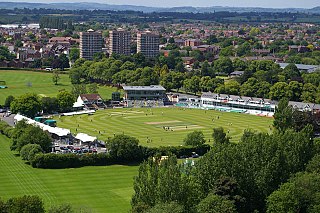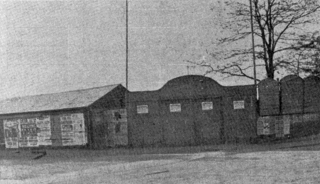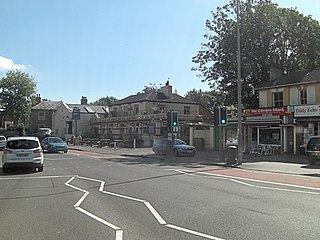
Charles Phillip Mead was an English first-class cricketer. He played as a left-handed batsman for Hampshire and England between 1905 and 1936. He was born at 10 Ashton Buildings, second eldest of seven children. As a child he played for South London Schools, attending Shillingstone Street School.

Visit Worcestershire New Road is a cricket ground in the English city of Worcester. The home of Worcestershire County Cricket Club since 1896, it has been rated as one of the world's most beautiful cricket grounds.

Hampshire County Cricket Club is one of eighteen first-class county clubs within the domestic cricket structure of England and Wales. It represents the historic county of Hampshire. Hampshire teams formed by earlier organisations, principally the Hambledon Club, always had first-class status and the same applied to the county club when it was founded in 1863. Because of poor performances for several seasons until 1885, Hampshire then lost its status for nine seasons until it was invited into the County Championship in 1895, since when the team have played in every top-level domestic cricket competition in England. Hampshire originally played at the Antelope Ground, Southampton until 1885 when they relocated to the County Ground, Southampton until 2000, before moving to the purpose-built Rose Bowl in West End, which is in the Borough of Eastleigh on the north east outskirts of Southampton. The club has twice won the County Championship, in the 1961 and 1973 seasons.

James Southerton was an English professional cricketer who played Test cricket for England in 1877, and first-class cricket between 1854 and 1879. His domestic career was spent largely with three counties: Hampshire, Surrey, and Sussex. He would sometimes play for multiple counties in a season, earning him the moniker the 'Man of Many Counties'. Having began his career as a batsman, it was not until later in his career that he developed into a formidable roundarm slow bowler, becoming, alongside Alfred Shaw, the greatest slow bowler of the 1870s. He was the first man to take 200 first-class wickets in a season, a feat he achieved in 1870. In his first-class career, he would take nearly 1,700 wickets from 286 matches, at an impressive bowling average of 14.43. Southerton toured Australia in 1876–77 with James Lillywhite's side, playing in the first-ever Test match between England and Australia at the Melbourne Cricket Ground. At 49 years and 119 days old when he made his Test debut, he is the oldest Test debutant ever; his Test career comprised the two Tests played on the 1876–77 tour, with Southerton taking 7 wickets.
The Brush Ground was a cricket ground in Loughborough, Leicestershire. Owned by the Brush Electrical Machines Company and used by the company cricket team, it was used as an outground by Leicestershire. They first played there in a first-class match against Hampshire in the 1953 County Championship. Leicestershire played there at least once a year until 1965, playing sixteen first-class matches. The ground was later purchased by Leicestershire County Council in 2017, with the ground redeveloped for residential purposes. The sports club moved to new premises three–times the size Nanpantan Road in Loughborough.

Edward Sainsbury was an English cricketer who represented, and captained, Somerset County Cricket Club in the late 19th century. During a 10-year first-class cricket career, he also represented Gloucestershire and the Marylebone Cricket Club (MCC).

The Antelope Ground, Southampton was a sports ground that was the first home of both Hampshire County Cricket Club, who played there prior to 1884, and of Southampton Football Club, who played there from 1887 to 1896 as "Southampton St. Mary's F.C."

May's Bounty is a cricket ground situated along Bounty Road in Basingstoke, Hampshire, England. The ground is compact and is lined on all sides by trees, with its northern side overlooked by residential housing. The Bounty was used intermittently by Hampshire County Cricket Club in the early 20th-century, before Hampshire began to play there annually from 1966 to 2000.

The United Services Recreation Ground is a sports ground situated in Burnaby Road, Portsmouth, Hampshire, England. The ground is also bordered to the north by Park Road, along which the railway line to Portsmouth Harbour and Gunwharf Quays overlooks the ground, and to the east by Anglesea Road. The southern end of the ground is dominated by the Officer's Club building, which overlooks the ground. The ground is owned by The Crown. A multitude of sports have been played at the ground, including cricket, rugby and hockey. The ground was used by Hampshire County Cricket Club from 1882 to 2000, serving as one of three home grounds used during this period, alongside the County Ground, Southampton, and Dean Park, Bournemouth. United Services Portsmouth Cricket Club currently play at the ground. The ground is used in its dual capacity as a rugby venue by United Services Portsmouth Rugby Football Club, who have played there since 1882. The Royal Navy Rugby Union also use the ground for their home matches. The end names are the Railway End to the north and the Officer's Club End to the south.
J. Samuel White's Ground is a sports ground in Park Road, Cowes, Isle of Wight, England. The ground is owned by the Isle of Wight Council and is surrounded by residential housing. A multitude of sports have been played at the ground, including cricket, football and bowls.
The Officers Club Services Ground is a cricket ground in Aldershot, Hampshire, England. The ground was used as a host venue for first-class cricket by Hampshire and various armed services teams from 1905 to 1964, hosting nine matches. A Women's Twenty20 International was played there in 2011.
Daniel Day was an English first-class cricketer. Day was a right-handed batsman who bowled right-arm roundarm fast-medium. Day is widely regarded as one of the best bowlers of early English cricket.

Sir Frederick Hutchison Hervey-Bathurst, 3rd Baronet was an English cricketer who played for Hampshire, MCC and the Gentlemen of England. He was a right-handed batsman who bowled right-arm roundarm fast.
Batsford Road, sometimes known as Moreton-in-Marsh Cricket Club Ground, is a cricket ground in Moreton-in-Marsh, Gloucestershire. The ground is located off the Batsford Road as it leaves Moreton-in-Marsh. It played host to first-class and List A cricket matches for Gloucestershire County Cricket Club between 1884 and 1996.
Somerset County Cricket Club made their debut in first-class cricket in the 1882 English cricket season. They were captained by Stephen Newton, and played eight first-class matches, five against county opposition, two against the Marylebone Cricket Club and one against the touring Australian team. They only won one of the eight contests, that against Hampshire at Taunton. Of the other matches, one was drawn and the other six were all losses for Somerset. Wisden Cricketers' Almanack described the season as "disastrous", but the publication qualified this statement with mild optimism for 1883.

The Rose Bowl, known for sponsorship reasons as Utilita Bowl, is a cricket ground and hotel complex in West End, Hampshire. It is the home of Hampshire County Cricket Club, who have played there since 2001.

Day's Itchen Ground was a cricket ground in Southampton, which hosted first-class cricket from 1848 to 1850.









